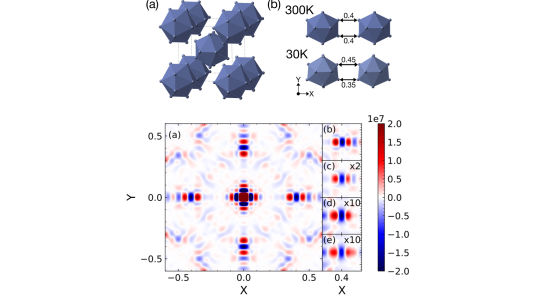
3D-ΔPDF maps: Differences in the probabilities of the tin-tin vectors compared to the average structure. Positive values (red) show that the tin ion displacements from their average positions (blue) do not change with temperature, even above T꜀ = 130K, (b) 30K, (c) 100K, (d) 120K, (e) 150K.
Scientific Achievement
3D-ΔPDF maps show that local atomic distortions are temperature-independent below and above structural phase transitions in quasi-skutterudite compounds, a signature of order-disorder behavior.
Significance and Impact
3D-ΔPDF methods can distinguish ‘order-disorder’ from ‘soft-mode’ phase transitions by analyzing both the average structure and local fluctuations.
Research Details
- Single crystal diffuse scattering measurements were performed on (CaxSr1-x)3Rh4Sn13, which have structural phase transitions with a quantum critical point at x = 0.9.
- The data were transformed into 3D pair distribution functions, using a novel Gaussian filter method that reveals short-range order in real space.
- These reveal that the amplitudes of distortions are independent of temperature, below and above Tc.
Argonne National Laboratory seeks solutions to pressing national problems in science and technology. The nation’s first national laboratory, Argonne conducts leading-edge basic and applied scientific research in virtually every scientific discipline. Argonne researchers work closely with researchers from hundreds of companies, universities, and federal, state and municipal agencies to help them solve their specific problems, advance America’s scientific leadership and prepare the nation for a better future. With employees from more than 60 nations, Argonne is managed by UChicago Argonne, LLC for the U.S. Department of Energy’s Office of Science.
The U.S. Department of Energy’s Office of Science is the single largest supporter of basic research in the physical sciences in the United States and is working to address some of the most pressing challenges of our time. For more information, visit https://energy.gov/science.